Last night I finished week three of this summer’s hand embroidery classes. Well, I call it week three, even though yesterday was just Wednesday. All five classes are packed into the first three days of the week. Would someone please remind me not to do that next year??!! I’ve got a few photos here of some of the class projects that have been finished…
With five embroidery classes going for different age levels – and different levels of ability – all crammed into the first three days of the week (Mon – Wed), by Wednesday evening’s class, I’m mixing up embroidery threads, fabrics, projects… In my Wednesday evening class, for example, half the class is working with DMC stranded floss on flour sack towels, the other half is working with DMC Satin Floss (rayon) on embroidered greeting cards, and one younger youngster is working with pearl cotton on a felt bookmark.
Now, you may rightly wonder why things aren’t more organized, but there are a couple little difficulties:
The first obvious one is that the children tend to work at entirely different speeds, with entirely different levels of enthusiasm. Some go home and stitch their hearts out and finish each new project before the next time we meet. These fast little stitchers – who are usually the enthusiastic and meticulous kids with real interest and talent – are ready for a new project each week practically!
Then there are what I call The Lagging Stitchers – the kids who don’t do anything on their projects during the week. They come into class forgetting what they learned in the last class, because they haven’t picked up their needlework at all. This requires me to “reteach” some of the students in every class, which is inconvenient for me and for the other students, and hampers the progress we could make otherwise. I haven’t figured out how to handle this yet, and yet, I’ve faced this every year.
And finally, in some classes, there’s a real disparity in age. Some of the children come from Really Rural Kansas, and to make the extra drive into town each week is a hardship on the parents. So if there’s an older and younger child from the same family signed up, they often come to the same class, despite their age difference. The disparity in age is reflected in the disparity in development – there is a vast difference between the level of physical development (think fine motor skills!) of a 10 year old and that of a 7 year old. Which means I have to have the Little-Little Kids’ projects going in the Medium-Little Kids’ classes and in the Big-Little Kids’ classes as well. Take, for example, the Wednesday class. There are 11 students, and their age range is supposed to be 12 – 14, but it’s really 10 – 14, with a 7-year-old thrown in for good measure!
Whew.
But – really – it’s a blast! And there’s nothing better than seeing the results start to come together. Here are some needlework developments from the classes so far.
First, an embroidered dish towel. This is stitched by an 11-year-old. The towel’s already been laundered, hence the wrinkles.
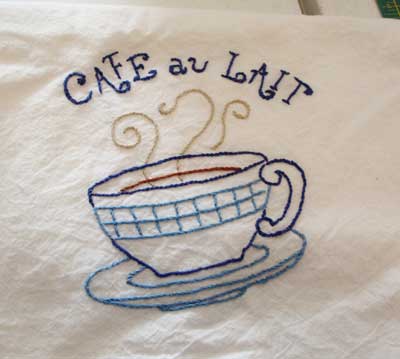
These are the Aunt Martha designs from the set called “Java Break.” She worked the whole piece in stem stitch.
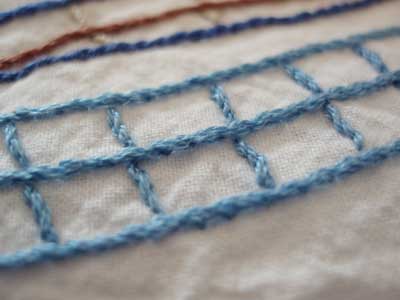
And she does a really nice job on her stem stitch!
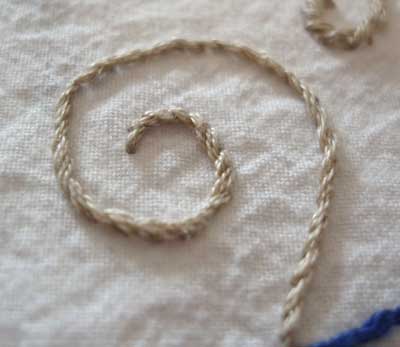
Her stitches are even and neat.
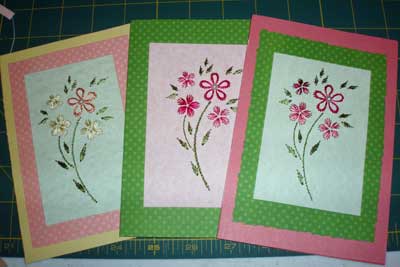
Three embroidered cards were finished last night… the embroidery was finished on several more, but the cards haven’t been assembled yet.
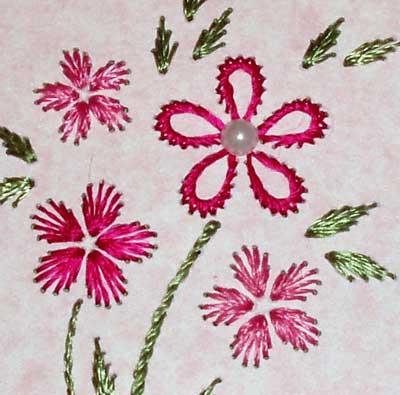
The pattern for these three cards was selected from one of Erica Fortgens’s books on embroidered greeting cards. I’ve got all her books on my shelves, so the kids flip through to see what they like when it’s time to delve into a project. They’re super-terrific books!
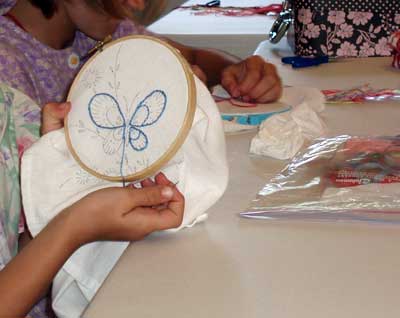
And here, one of the kids from the 7-9 year olds’ class is showing off her embroidered butterfly towel as it progresses.
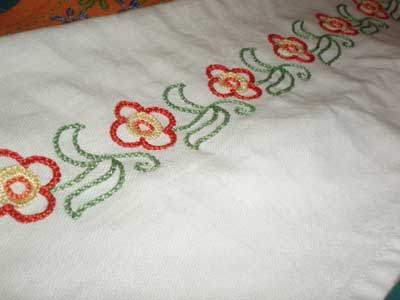
And here’s another kitchen towel… actually, I stitched it. It’s a project sample. A couple of the kids are working on this design right now (in the Medium-Little Kids’ class – ages 10 & 11). I’m looking forward to seeing the results on this one!
So, there’s progress for you!
As each summer passes, I learn something new about teaching these classes. This year, my reflection is going to include trouble-shooting the age / level disparity problem and figuring out once and for all how to handle Lagging Stitchers.
Any ideas on those subjects??







Uff!
I only read your class description and I am tired! 🙂
But you got good results. Congratulations!
Im not exactly sure how your class works for sure But What I was thinking is if you were to ask one of the more talented older children that was local to work as a helper for the classes that have age disparity. especially if you know in advance. You could even plan asking one of your students from this year to help next year kind of like a mother’s helper only a teacher’s helper. you can pay this child or give her a project of her choice or give her a free lesson in one of the advanced groups. In a way you can mentor someone and make your job alittle easier.
I love reading about your classes because I never know when I’ll be teaching a kid (or adult) so I file away info in my head. I really like Crazyqsis’s idea of a helper other than that I think your idea of just plain being flexible is key. Whenever I have gotten some to teach it seems that flexibility to go with the flow seems the best solution.
Mary,
I don’t have any suggestions for you, but I have to hand it to you. This is wonderful! To see such progress from young stitchers must be so satisfying to you.
Keep up the good work. You are an inspiration! 🙂
I’ve been a leader of a Young Textile and Fibre Group club in Sydney Australia now for 7 years. In that time I’ve taught about 50 different children of different ages and ability levels.
I don’t know what your expectations are of the kids, but in our Group we are trying to get the kids started on the road to a lifetime of enjoyment of the needle and thread. We don’t emphasise perfect stitching, or even completed projects so much as experiencing a little of several different techniques, working with different threads and learning the basics. Some of the Clubs within the Group have short formal stitching lessons, but my own group tries to do a small project each month within the 3 hour time frame. Sometimes they DO complete it, and I try to design projects that are achievable for the youngest and slowest stitcher. The more dexterous and olders stitchers often work a little more into the project or take home the materials to add a little something extra.
On the whole, the Club works well. There are always the ones who turn up at the end of a lesson with untidy work but so proud of having finished it. There are students who undo uneven stitches, re-stitch and fuss over their work. I’m just happy that they do their best, whatever it is, and enjoy the experience. I often hear from adults that they were taught to stitch years ago at school where they were made to undo and restitch so many times that they created holes in the fabric. They now HATE stitching with a passion. Our policy at the YTFG is to have FUN with stitching, and build the foundation for the future.
I’m fortunate to have parent and grandparent helpers at my Club who stay and help with re-threading needles and encourage the kids. There is no answer to the disparity in skill levels, flexibility is the only answer and yes, I often come home at the end of the day EXHAUSTED from teaching. I often think if I’m NOT tired that the lesson did not go so well, LOL. We mighn’t be producing exhibition quality work yet, but the kids are enjoying their experience with fibre and threads and hopefully will continue on into adulthood.
In fact, in the past 13 years since the YTFG began in New South Wales several of our “graduates” have gone on to take Textiles at High School level with stunning results. They credit their start at YTFG for giving them the edge.
You can see some of our projects etc. at
http://ytfgmembers.blogspot.com/
Hooroo,
Christine in wintry Sydney
Hi, All –
Thanks for your comments!
I’ll be posting again on this subject!
Best regards,
Mary
Great stuff! I love seeing pics from your classes!
Everything I’m thinking of with regard to suggestions for kids lagging behind is turning into three page essays. Bleh, I’m wordy! I feel an email coming on. LOL!
Mary, I love that border you’ve done on the towel in the last pic! – Jeannine
mary thank you for all you do. i love it all. i have a daughter 30 with downsyndrome. she wants to learn to embroider. i think today i will show her. i will make something simple so she can start. thank you again for your website, its the best ever. God bless you.
Hello, Mary- Happy 4th!
Try this- instead of dividing classes by age, sort them by level of ability such as beginner needlepoint, intermediate cross stitch, 1st level advanced, 2nd level advanced, etc. This way, the slower ones don’t feel pressured to keep up when they really can’t.
The siblings that arrive together- try this- have the “waiting” one complete her work or repeat her work in different color or on different fabric so that you can concentrate on the others. You can also ask if that student would help sort through thread colors or some other fun chore that they wouldn’t mind doing.When an older child is waiting, this is your helper, since any child would love to be a teachers helper rather than wait idly by. It is okay to have waiting students if they are kept busy and safe.
I think to motivate the stitchers that lag behind for “whatever” reason, age or skill or maturity…try a good old fashioned bribe…lol For instance you could set a portion of the design to be finished by the end of the session then receive a reward (sewing related of course-maybe a free DMC 6-strand floss or a new needle, something inexpensive) then if they finish the project you could raise the dollar value of the reward. This is all based on an assumption that you can afford to do this. If not, you could still give away hand embroidery designs that you have made copies of OR you could do what I let my granddaughters do and let them choose designs from a basic coloring book.
i like very very much the pink flowers card